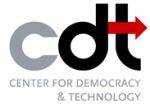While geolocation based services have been in the forefront of our minds lately, with websites like PleaseRobMe making us second guess announcing our whereabouts, another industry has been quietly ramping up its data collection practices.

The Center for Democracy & Technology issued a report yesterday addressing the growing “digital signage” industry, suggesting a number of privacy practices it might adopt.
For the uninitiated, digital signage is just that – digital advertisements displayed in the real world on a screen. The name, however, does not give away the full capabilities of these devices, as they can also contain RFID scanners, video cameras and processing abilities to do a number of interesting tasks, such as facial recognition. They can be fully Internet-connected, meaning they can not only store data but compare it to online databases to customize ad displays according to any number of criteria, from the iPhone in your pocket to the type of car you are driving.
One somewhat eerie scene in Minority Report that the digital signage industry is surely tired of shows the potential of digital signage. Two years ago, this type of technology, which identifies passers-by individually and tailors ads with data it has collected about them, was predicted to be five to 10 years away.
We spoke with Harley Geiger, the author of the CDT’s report, and he said that, “for now digital signage does not quite identify people on an individual basis” but that the “CDT argues that the industry will one day routinely identify individuals for the simple reason that it will be profitable to do so.”
Some companies, Geiger says, are already storing information such as phone numbers and usernames, as it would get from an smartphone. Even if they do not store this information, other data, such as a MAC address, which is a unique number assigned to a piece of hardware, is only a step away from being connected to an individual’s unique identity.
“While it is encouraging that companies say they are committed to maintaining the anonymity of individuals right now,” Geiger wrote in an email, “the technology and infrastructure is not yet poised for widespread individual identification… so the pressure to identify individuals will come.”
According to a blog post on the CDT website, this report includes “a set of recommendations for safeguarding privacy as the DOOH industry increasingly adopts identification and tracking technologies, such as facial recognition, mobile marketing, social networking, RFID tracking and license plate scanners.”
“Right now, however, the more worrying trend is with transparency,” wrote Geiger.
He says that, while some “Digital Out Of Home” companies offer privacy policies on the Internet, many others do not have anything online nor at the location of the digital signage itself.
“Technology vendors are the most likely to have privacy policies up on the Web – but how are consumers in a department store supposed to know who the technology vendor for a particular sign is?” Geiger asks.
The report does not call for an end to digital signage. Instead, Geiger says that the CDT feels that “the industry must weave transparency, consumer privacy and security controls into its business model.”
“Unless the industry adopts strong self-regulatory guidelines, it is likely to face consumer backlash and reactive government regulation that may stifle innovation,” Geiger writes in his blog post. “It will only take a few bad apples that flout consumer privacy expectations to spoil the image of the whole industry.”
The digital signage industry may be tired of the scene in Minority Report, where holograms and digital signs address Tom Cruise’s character by name, but that’s because it’s a future we hope to never live in. If we wanted everyone to know exactly who we were everywhere we went, then we’d all be wearing name tags and t-shirts with our CV screen printed on them. But we don’t, because despite the rather public age of the Internet we’ve entered, we still like to entertain even the smallest semblance of privacy. We hope that the CDT’s recommendations do something to keep these technologies useful, but in check.
For more information on what the Center for Democracy & Technology is doing to ensure our privacy in this realm, read Harley Geiger’s blog post on his experience at last week’s Digital Signage Expo 2010.





















